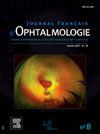Efficacy and safety of micropulse versus continuous wave transscleral diode cyclophotocoagulation in treating glaucoma
IF 1.1
4区 医学
Q3 OPHTHALMOLOGY
引用次数: 0
Abstract
Introduction
The goal of this study was to compare the efficacy and tolerability of conventional transscleral cyclophotocoagulation (CW-TSCP) versus micropulsed diode laser (MPTLT) in the treatment of glaucoma.
Materials and methods
In this single-center retrospective study, all patients treated with CW-TSCP or MPTLT between January 2018 and December 2020 at Nantes University Hospital with at least one month of follow-up were included. Intraocular pressure (IOP), glaucoma medications, use of new laser treatment and complications were recorded at 1, 3, 6, 12 and 24 months. Success was defined as an IOP of 6–21mmHg or a ≥ 20% IOP reduction from the preoperative measurement, with the same or fewer glaucoma medications and no alternative glaucoma surgery.
Results
Thirty-seven eyes treated with MPTLT and 26 eyes treated with CW-TSCP were included. At the last visit (median = 16 months), 69% of eyes treated with CW-TSCP and 54% treated with MPTLT met the success criterion (P = 0.720). The mean reduction in IOP from baseline was 8.0 mmHg in the CW-TSCP group and 2.1 mmHg in the MPTLT group (P = 0.030). The mean reduction in medications was 1.24 in the CW-TSCP group and 0.6 in the MPTLT group. Among patients treated with oral acetazolamide, 9 patients (69%) in the CW-TSCP group and 3 patients (33%) in the MPTLT group had discontinued the acetazolamide. Persistent hypotony was a significantly more frequent complication in the CW-TSCP group (n = 3; 8%) than in the MPTLT group (n = 1; 2%).
Conclusion
While both CW-TSCP and MPTLT are effective treatments for lowering IOP over an extended period, CW-TSCP resulted in a more substantial reduction in IOP and greater decreases in the need for glaucoma eye drops and oral acetazolamide, albeit at the cost of a higher incidence of persistent hypotony. Further prospective randomized studies are needed to confirm the superior efficacy of CW-TSCP over MPTLT and to better assess its tolerability.
Introduction
L’objectif de cette étude est de comparer l’efficacité et la tolérance de la cyclophotocoagulation transclérale conventionnelle (CW-TSCP) par rapport au laser diode micropulsé (MP-TLT) en traitement du glaucome.
Matériels et méthodes
Tous les patients traités par CW-TSCP ou MP-TLT entre janvier 2018 et décembre 2020 au CHU de Nantes ont été inclus. Le tonus oculaire (TIO), la prise d’hypotonisants, le recours à un nouveau traitement laser ainsi que les complications, ont été recueillis à 1, 3, 6, 12 et 24 mois. Le succès a été défini comme une tension oculaire entre 6 et 21 mmHg ou une baisse tensionnelle d’au moins 20 % et en l’absence d’augmentation du nombre d’hypotonisants et de recours à la chirurgie.
Résultats
37 yeux traités par MPTLT et 26 yeux traités par CW-TSCP ont été inclus. A la dernière visite (médiane 16 mois), 69 % des yeux traités par CW-TSCP et 54 % des yeux traités par MPTLT ont validé le critère de succès (p = 0,72). CW-TSCP a permis une baisse tensionnelle de 8 mmHg contre 2,1 mmHg pour le MPTLT (p = 0,03). La diminution du nombre de molécules hypotonisantes a été de 1,24 dans le groupe CW-TSCP contre 0,6 dans le groupe MPTLT (p = 0,045). Parmi les patients traités par acetazolamide oral, 69 % des patients ont pu être sevrés dans le groupe CW-TSCP contre 33 % dans le groupe MPTLT. 8 % des yeux traités par CW-TSCP contre 2 % des yeux traités par MPTLT ont présentés une hypotonie (TIO < 6 mmHg) (p = 0,006).
Conclusion
Bien que la CW-TSCP et la MPTLT soient toutes deux des traitements efficaces pour réduire la PIO sur une période prolongée, la CW-TSCP a permis une réduction plus importante de la PIO, une diminution plus importante du nombre d’hypotonisants, mais au prix d’une incidence plus élevée d’hypotonie persistante. Des études prospectives randomisées sont nécessaires pour confirmer l’efficacité et le profil de sécurité de chaque procédure afin de mieux définir leurs places dans l’algorithme de prise en charge du glaucome.
微脉冲与连续波经巩膜二极管光凝治疗青光眼的疗效及安全性
本研究的目的是比较常规经巩膜光凝(CW-TSCP)与微脉冲二极管激光(MPTLT)治疗青光眼的疗效和耐受性。材料与方法在这项单中心回顾性研究中,纳入了2018年1月至2020年12月期间在南特大学医院接受cwtscp或MPTLT治疗并随访至少1个月的所有患者。分别于1、3、6、12、24个月记录患者眼压、青光眼药物、新型激光治疗的使用情况及并发症。成功的定义是IOP为6-21mmHg或IOP比术前降低≥20%,使用相同或更少的青光眼药物,没有替代青光眼手术。结果MPTLT组37眼,CW-TSCP组26眼。在最后一次访视(中位= 16个月)时,69%的CW-TSCP治疗组和54%的MPTLT治疗组达到了成功标准(P = 0.720)。CW-TSCP组IOP较基线平均降低8.0 mmHg, MPTLT组平均降低2.1 mmHg (P = 0.030)。CW-TSCP组的平均减量为1.24,MPTLT组的平均减量为0.6。在口服乙酰唑胺治疗的患者中,CW-TSCP组9例(69%)患者和MPTLT组3例(33%)患者停止使用乙酰唑胺。持续性斜视是CW-TSCP组(n = 3; 8%)比MPTLT组(n = 1; 2%)更常见的并发症。结论:虽然CW-TSCP和MPTLT都是长期降低IOP的有效治疗方法,但CW-TSCP导致的IOP降低更为显著,青光眼滴眼液和口服乙酰唑胺的需求也更大,尽管代价是持续低眼压的发生率更高。需要进一步的前瞻性随机研究来证实CW-TSCP优于MPTLT的疗效,并更好地评估其耐受性。摘要目的比较激光二极管微脉冲激光(MP-TLT)在光敏变性治疗中的效果,并对激光二极管微脉冲激光(CW-TSCP)在光敏变性治疗中的作用进行了比较。所有的患者都有自己的人格特质,如CW-TSCP, MP-TLT中心,2018年1月和2020年1月在CHU de Nantes,其中包括:Le强直性oculaire (TIO),拉撬d 'hypotonisants, Le recours联合国新traitement激光依照ainsi les并发症,安大略省的recueillis 1, 3、6、12等24个月。3个月的成功,1个月的成功,1个月的成功,1个月的成功,1个月的成功,1个月的成功,1个月的成功,1个月的成功,1个月的成功,1个月的成功,1个月的成功,1个月的成功,1个月的成功,1个月的成功,1个月的成功,1个月的成功,1个月的成功,1个月的成功,1个月的成功,1个月的成功。其中, 。一项关于成功标准(p = 0.72)的调查显示,69%的成功标准与CW-TSCP一致,54%的成功标准与MPTLT一致(p = 0.72)。CW-TSCP在8 mmHg和2、1 mmHg的压力下被允许(p = 0.03)。CW-TSCP组与MPTLT组相比,前者与前者相比,前者与后者相比有显著性差异(p = 0.045)。经口服乙酰唑胺治疗的Parmi组患者中,有69%的患者服用了口服乙酰唑胺,有69%的患者服用了口服乙酰唑胺,有33%的患者服用了口服乙酰唑胺。在低张力(TIO < 6 mmHg)的情况下,8%的个体与CW-TSCP相比,2%的个体与MPTLT相比(p = 0,006)。ConclusionBien乘缆车CW-TSCP et la MPTLT数字所有两个des traitements efficaces倒reduire la PIO苏尔里面prolongee, la CW-TSCP +重要de la PIO,有的一个减少一个减少加重要的du数量d 'hypotonisants,但非盟站一个发病率+ elevee d 'hypotonie persistante。将预期的随机的、不确定的、不确定的、不确定的、不确定的、不确定的、不确定的、不确定的、不确定的、不确定的、不确定的、不确定的、不确定的、不确定的、不确定的、不确定的、不确定的、不确定的、不确定的、不确定的、不确定的、不确定的、不确定的、不确定的、不确定的、不确定的。
本文章由计算机程序翻译,如有差异,请以英文原文为准。
求助全文
约1分钟内获得全文
求助全文
来源期刊
CiteScore
1.10
自引率
8.30%
发文量
317
审稿时长
49 days
期刊介绍:
The Journal français d''ophtalmologie, official publication of the French Society of Ophthalmology, serves the French Speaking Community by publishing excellent research articles, communications of the French Society of Ophthalmology, in-depth reviews, position papers, letters received by the editor and a rich image bank in each issue. The scientific quality is guaranteed through unbiased peer-review, and the journal is member of the Committee of Publication Ethics (COPE). The editors strongly discourage editorial misconduct and in particular if duplicative text from published sources is identified without proper citation, the submission will not be considered for peer review and returned to the authors or immediately rejected.

 求助内容:
求助内容: 应助结果提醒方式:
应助结果提醒方式:


